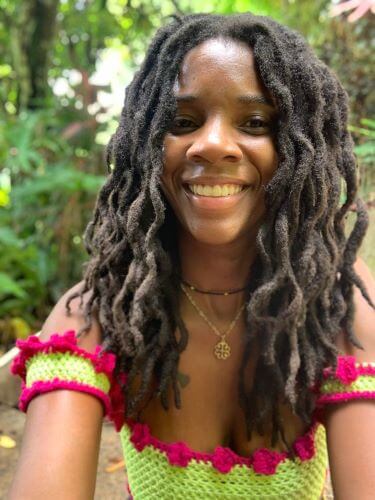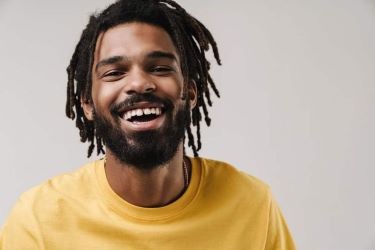Do you know semi freeform dreads? Many people want to try out dreadlocks but don’t know which way is the right option for locking their hair.
It might be exhausting to take lots of effort and still end up choosing the one not available for you. It is recommended to start with the easy and natural semi-freeform dreads.
They are well-known for their perfect combination of freeform locs and other manipulation ones. The true essence of semi-freeform dreads allows us to have a natural look with a few simple steps.
Follow us to explore what is real semi-freeform dreads and how to get and maintain them.
What are Semi-Freeform Dreads?
Semi-Freeform dreads are a trendy and common type of dreadlock for starter locs. They usually started by twisting or palm-rolling your natural hair to grow your locs. As its name shows, we can consider it as a combination art of freeform dreads and traditional dreads.
Traditional dreads, usually start with a parting method. And then palm rolling or interlocking to create equal size dreads and certain loc shapes. While freeform dreads starting with any manipulation at all. It will have natural dreads without equal size for the final look.
And the essentiality of semi-freeform dreads has benefits in both ways. This style allows us to use a method to form our dreads at the initial start while still giving off a natural look. It is a great option for people who would like a less matted and neater look but not much effort.
How to Get Semi-Freeform Dreads?
Now, let’s take a step-by-step tutorial about how to get the amazing semi-freeform dreads.
Step 1: Wash and Dry
First of all, it is important to have an in-depth cleaning of the whole hair before we start forming steps. As our hair or dreads are easy to attract dirt and will leave impurities and residues from time to time. Wash our hair and scalp with some residue-free shampoo to remove all the dirty buildup.
Then ensure you dry the entire head as soon as you finished washing. We can use a microfiber towel to avoid lint into hair or a hairdryer. Make sure your hair is completely dry before we start the next step as damp hair will not be helpful at all.
Step 2: Sponging or Towel Rubbing
Now let’s keep on to the next main part to develop your semi-freeform dreads step by step. For this step, there are many ways to create them such as sponging, towel rubbing, backcombing, or finger twisting. You can choose either way you like to go with.
For example, we can take a curl or twist sponge to roll it around from roots to ends of your hair in a circular motion. Sponging will help our hair to starts twists in a thicker shape. Make sure that keep the sponge in the same direction throughout the process.
Besides, it is better to use the sponge to twist for the first couple of months. And then try to use the towel rubbing for the next few months.
Step 3: Let It Do Its Thing
The last step of the semi-freeform dreads process is to leave your hair to grow mature and form by itself. And we may need to do some re-twisting for some time to avoid dreads tangling and mixing during this stage. In the end, we should learn to be patient to see our locs start to form naturally after a couple of months.

The Pros of Semi-Freeform Dreads
There are many significant pros to semi-freeform dreads during the whole formation stages.
Natural Locking
The most common benefit is their natural locking through the formation process. This is the fundamental and essential of semi-freeform dreads. The way how to make semi-freeform dreads allows us to grow our hair organically to lock.
For people who don’t like lots of chemicals in hair products, semi-freeform dreads are a great option. Many traditional locs styles or methods are using a wide range of chemical hair products. And we all know that they usually may contain some harsh materials or leave many heavy residues in our hair.
Minimal Maintenance
Another con of semi-freeform dreads is the minimal maintenance in the long run. Once the semi-freeform locs are formed, they are easy to care of. Except for some maintenance effort, we should be mindful that the messier the better!
According to the ways of making semi-freeform dreads, we only need stuff like a sponge, towel, or fingers to keep them re-twisted. For most people, we can make them at home by ourselves instead of having salon visits very often. This will help to save lots of our time and make it more affordable for us.
Versatile Styling
One of the most significant advantages of semi-freeform dreads is their various hairstyles. It is a versatile style that can fit us well with formal and casual events for both women and men.
For example, we can have high buns with semi-freeform dreads for formal events. And have high ponytails with semi-freeform dreads for casual activities.
Further, semi-freeform dreads also allow us to have some unique expressions possible. Unlike other traditional dreadlocks, semi-freeform dreads leave us with lots of possibilities. It is a great way to show your personal preference and free spirits with its less uniform shape look.
Suitable for Active Lifestyles
The last significant advantage is their suitability for active and dynamic lifestyles. The minimal maintenance of this style is easy for us to take care of while having some sports or outdoor events. With semi-freeform dreads, we won’t need to worry a lot about loc or styling damage if our locs got dirty.
Moreover, they are also convenient for us to wear on the go. It is a good option for people who may need to go to many different places for work or travel to relax. As we don’t need to wash them very often or go to the salon very often to keep better maintenance.

The Cons of Semi-Freeform Dreads
Besides the great pros of semi-freeform dreads, there are also some minor cons. We should take into consideration of them before we start.
Less Defined Shape
While natural locking is one of the pros, it will also lead to a less uniform and consistent shape in the final look. They are hard to be structured in certain defined shapes during their development. For people who have high expectations of a perfect look, it might not be the ideal choice for you.
Although semi-freeform dreads are neater than freeform dreads, they still give us a look of mess. And it is considered that the messier the better. So if you are seeking a more polished look, it might be hard to achieve for you.
Potential for Loose Hairs
One of the biggest issues that we must consider is the potential for natural frizz and loose hair. It may become very problematic and hard to fixable over time. So we should be mindful and take some techniques to address the frizz and loose hair while the formation.
For example, we can try to brush our locs with a loc comb while they are wet after washing. Also, we can nourish and moisturize our hair to reduce dryness and breakage which will be helpful too. While we try to manage frizz, we should be mindful that addressing it without compromising the semi-freeform style.
Longer Locking Process
The last demerit is the longer locking process compared to other manipulated styles. As the locking process needs our hair to grow naturally. It requires time to become stronger.
You can not rush to get the results with this style. On average, it will take 3-6 months before you see any actual progress.
And it can take up to 2 years for the mature locs.
In that case, we should be faithful and attentive to our natural hair. And embrace the gradual locking process as possible as we can. The more patient you are, the better they will form.

How to Care for Semi-Freeform Dreads
As mentioned above, we won’t need to put lots of effort into the maintenance of semi-freeform dreads. Yet, there are still certain suggestions that should be mindful of to keep our dreads healthy.
Cleansing Dreads
First things first, one of the most essential steps in maintaining is to keep them clean. There might be some misconceptions from people that semi-freeform dreads are less neat. We must wash them regularly to keep a healthy scalp and roots.
We should always keep an eye out for buildup in the hair to avoid roots thinning. It is better to wash semi-freeform dreadlocks at least once a week or two. And we also recommend using some residue-free shampoo to get rid of buildup.
Besides, always make sure you always dry your dreads as soon as you finished washing.
Styling
Another essential suggestion for maintaining semi-freeform dreads is styling. It is great that semi-freeform dreads allow us to try out various hairstyles in different looks. Yet, we should be mindful to commit to minimal styling and tension in the initial days.
When you style a lot daily it might cause dreads to lose the shape of your delicate natural hair. So during the initial stages, we can try some loose bun or pony hairstyles. We can make our hair down and secure them with an easy band while limiting the use of tight rubber bands.
Separate Your dreads
Next, we should be mindful of their maintenance of them is the dread of separating. While we are taking an effort to take proper care of our hair, we may tend to forget to keep an eye out for hair roots. In fact, taking good care of our dreads root is as essential as washing and styling.
We can separate and dry our dreadlocks every time we wash our hair. By doing this, it can help to cut the chances of roots matting and split ends. Also, be mindful that don’t put excessive tension on your roots may lead to long-term thinning at the root.
Self-Grooming
Next, we should keep in mind to practice self-grooming techniques for our maintenance. Every time we wash your hair, we can do some grooming to reduce the heaviness of loss hair and build-up. And for some people in a humid climate or who sweat a lot, we can also do grooming when hair gets damp.
Further, hair product build-up and other environmental factors may also lead to thinning at the root. In that case, we need to keep a strong hold on the roots of our hair. As semi-freeform dreads will become heavier over the long run.

Moisturizing and Hydrating
Commonly, moisturizing and hydrating are important in the maintenance process. There are many light products for us to choose from for maintaining moisture balance. Also, we can apply a light spray-on moisturizer as needed to restore moisture and keep it smooth.
By bringing in those moisturizing products we can see our dryness issues fading away. Further, it is helpful if we can build a rehydrate treatment according to our ease and schedule. For example, we can keep them every 1-2 months which can help to avoid using excess products.
Sleeping
Another maintaining suggestion that might be neglected by us is proper sleeping care. While we’re sleeping, our cotton pillowcases and sheets can pull or tug on our dreadlocks. In that case, it is a high chance that our delicate dreadlocks will tend to have dryness and lint.
So we should sleep with a satin scarf, bonnet, or some kind of special wrap overnight. As silk or satin will slide across our pillowcase that won’t leave any fibre on the dreads. By doing so will help to keep our hair friction and breakage to the least.
Re-twisting
It is crucial to re-twist with your semi-freeform dreads during the beginning stages. It is a great way to encourage natural locking while maintaining their structure. By doing so will also help to keep our roots strong and healthy so that they will grow healthy.
Besides, we should keep in mind that doing re-twist less often after the beginning stages. As our semi-freeform dreads will tend to look frizzy due to frequent re-twisting. Re-twisting after every 2-3 months is great to prevent the dreads to loosen or untwist as they grow.
Keep in mind that semi-freeform dreads should grow naturally. In that case, we should re-twisting them only when necessary.

How to Retwist Semi-Freeform Locs
Now, keep reading to know how to re-twist with your semi-freeform dreads. Let’s learn to use the common two-strand twists way for re-twisting step by step.
First of all, we can use some kind of detangling spray or natural oil to make our dreads smoother at first. It will make the whole re-twisting process much smoother and easier.
Then we part our hair into two sections and hold the top sections by using hair clips or bands. We can use a rat-tail comb or fingers to part the hair from ear to ear.
Next, we stretch out a small part of the bottom section of hair and begin to twist them with our fingers. And secure them by a small hair clip then repeat this step for the remaining sections of hair.
During this step, we can keep applying some hair lotion or curling gel to make them easier to re-twisting.
Lastly, wait for our first re-twisting hair hold for a while we can start again with two strands.
Re-twist two new separated sections of hair together into a bigger one and secure with a hair clip. And repeat the process on all your other dreads and remove the all clips from your hair.
Again, we can apply a small amount of natural oil or gel to help the re-twisting process smoothly.
FAQS
1. How Long Does It Take for Semi-Freeform Dreads to Lock?
There is no definite amount of time for your semi-freeform dreads to take to lock. It will depend on the type of hair you have and your hair care efforts. On average, semi-freeform dreads can take anywhere from 5 weeks – 2 years till it is formed and locked.
2. Can Semi-Freeform Dreads Damage Your Hair?
Generally, some traditional ways of forming dreads might lead to some heavy damage. For semi-freeform dreads, they have minor chances of negatively affecting our hair. As it let our hair grow naturally with less manipulation.
3. What Are the Stages of Semi-Freeform Dreads?
On average, there are 5 different loc stages during the whole loc process. It starts from the starter locs to the budding stage, teen stage, maturity stage, and the final rooted stage. Each stage will take about several months depending on our hair texture and length.

Conclusion
To sum up, semi-freeform dreads are a great way to start our dreadlock journey. They are natural locking, minimal maintenance, and versatile styling. While there are also some tiny cons, they are worth trying out and will be a very interesting journey for us!
Leave a comment to share your helpful ideas below.





